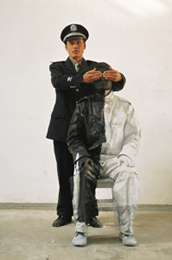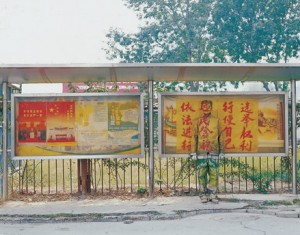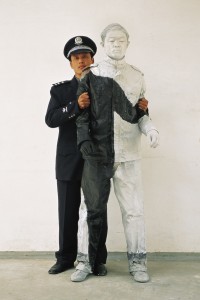« Features
Liu Bolin: Vigilance, Survival Instinct and Simulation
By Janet Batet
The fall of the Socialist block signified a radical change in contemporary culture. The pretexts underlying its credos collapsed before our very eyes. The distinctly polarized world we were accustomed to made way for a new era. The fundamental axes around which we had built our dreams, our ambitions, our cosmogonies and our fears ceased to exist. Above all, I refer to two axiomatic axes. The first -temporal in nature- put a definitive end to half a century of Cold War. The second -spatial in nature- did away with the clear split between East and West. Borders were no longer as pronounced, nor were our ways of thinking.
In the specific case of countries that had been socialist, dramatic, unprecedented liberalization and modernization processes started taking place. Art was one of the sectors most permeated by this democratization. The idea of innovation, intrinsic to this process, made New Art nomenclature flourish everywhere. Some constants were foreseen in all of these artistic movements. On the one hand, the manipulation of sacred icons and figures from the previous era -patriotic symbols, political leaders, slogans, the masses as collective heroes, etc. - allowed for the redefining of a still recent historic era, whose questioning had been taboo until then. On the other hand, manipulation of the stern tradition of Socialist Realism, with its attachment to the technique and tyranny of themes, now offered a new focus: parody. The artistic creations of Komar and Melamid or Erik Bulatov in Russia; Jose Angel Toirac or Rene Francisco and Ponjuán in Cuba; or the Luo Brothers or Liu Bolin in China, among others are emblematic of this process.
Liu Bolin was born in the province of Shangdong in 1973 and has been living since 1999 in Beijing, where he graduated with a degree in sculpture from the Central Academy of Fine Arts (CAFA) in 2001. His proposal comes from the process of change and liberalization that contemporary Chinese society has been experiencing. It is a traumatic change that imposes a bipolar culture in which tradition and foreign influence, the old and the new, are in conflict with each other, seeking new horizons.
Trapped in the midst of this process, the individual appears disoriented, displaced, skeptical, and he develops the most subtle of survival mechanisms. The environment, far from being stable, is ever changing, creating a kind of chameleon-like individual always willing to adapt to new decor. In Bolin’s words: “Ideology was written, then erased and later rewritten and then erased once again …” (1)
Bolin’s work is centered on the individual, an anonymous individual, lacking in any personal attribute that might distinguish him. In that sense there is a certain level of empathy for the tradition of Socialist Realism, in which the individual joins the masses in order to become an anonymous hero. Nevertheless, in Bolin’s creation the individual does not integrate himself into any collective; he is not an active -much less so, enthusiastic- participant in any process. Rather, he is by himself -with eyes closed, confirming the idea of introspection-. More than presence, his figures have something of the absent or phantasmagorical: they are inexpressive and immovable. Individuality has been effectively diluted in the pursuit of nothing. The distrustful individual prefers to go unnoticed behind the scenes.
In his series “Urban Camouflage,” Bolin introduces us to individuals who blend into the cityscape. The urban landscape makes reference to communal places: bus stops, streets, destroyed buildings where the icon appears as a vestige. We witness the prominence of symbols, which survive at an urban level in collective ideology. Sometimes posters completely dominate the scene as in “Camouflage 36,” or “Camouflage 31.”
In both works, the individual, standing up, is able to go unnoticed by blending into the background, leaving behind a barely visible silhouette. A slogan carelessly passes over the subject leaving its mark, molding him at its whim. The idea of atomizing individuality, no longer merging it with the masses, but instead with political posters, adds new levels of interpretation.
In Bolin’s oeuvre the human being appears isolated. There are a few exceptions in which the group appears as the protagonist. Even then interpersonal relationships are absent, and individuals persist in their immovability, their eyes closed. In “Camouflage 46″ we witness a family portrait with the flag of the People’s Republic of China appearing as an imposing background, as well as in the forefront, because the family has been absorbed by and fused with the patriotic concept.
When individuals oddly appear to interact, we observe an interesting approach. In “Camouflage 16″ and “Camouflage 17″ two individuals interact; they touch each other. In contrast to the rest of Bolin’s pieces in which the backgrounds are the real protagonists, here the background is restricted to the fundamental simplicity of the plane and the horizon, simply providing spatial placement for the figures. One of the individuals has an active, controlling attitude. Dressed in uniform, the law enforcement representative controls, compels, and decides for the second individual; depriving him of fundamental rights, such as, liberty of movement or visibility. In fact, only the police officer, impeccable and implacable -with eyes wide open- is total master of his identity, while the other anonymous individual is nothing more than a highly-transparent, flimsy silhouette that we can barely make out. In these pieces, Bolin has disturbed the traditional notion of entity-individual representation by giving shape to an abstract force (the police officer) and withdrawing the other person, almost making him disappear. In both cases the works are monochromes.
The series “Urban Camouflage” compels us to linger over its process of creation, bringing new levels of interpretation to the resulting work. The final product is the photograph that Bolin offers as a limited series. This idea, of creating a series and losing the original, acts as a supplement to the idea of the atomization of the individual, so dear to the work of this artist. The series itself never bears specific titles, just an interminable succession of numbers which organizes the works, one behind the other, in an endless sequence.
The other vital element from a technical standpoint is the range of appropriations the creative act implies for Liu Bolin, who participates in sculpture, performance, body-painting, and photography at the same time. The immobile individual himself becomes sculpture, a kind of mannequin that will become the central element of the performatic act, which involves the correct placement of the subject -at times, the artist himself- in the composition and subsequent camouflage process. Body-painting then makes its appearance. The figure begins integrating itself into the background until it disappears. As a last resort, the photograph appears, also acting as a simulation. In some instances, Bolin retakes the photo, transferring it to the canvas, thereby adding another degree of deterioration.
When we first approach “Urban Camouflage,” we have the impression that the optical illusion we perceive is the result of photographic manipulation. It is only afterwards, when we delve into the artist’s production and intention, that we discover the simulation. The work is not the result of digital manipulation; rather, it is the result of a meticulous and elaborate manual process that ties Bolin to the ancient tradition of the artisan, once again revealing significant antipodes, such as, tradition-modernity, east-west, the old and the new.
Bolin is a master of sculpture. Here, the idea of multiples is also fundamental. His series, “Red hand,” expresses this. Svelte, monochromatic figures -white or red- share a common space. There remains a lot of the infant in these figures, which already hint at puberty. Nude, deprived of all atavisms -at least at first glance- they would appear to be happy. Nevertheless, these creatures appear to have suffered some kind of mutation. There is no trace of eyes in their faces and the overprotective, all-powerful red hand is ever present. The series establishes itself as indispensable questioning for new generations emerging in the midst of a crisis of pretexts and a redefining of the past. The series is at the very least, disquieting.
With his series, “Olympic Warrior,” Bolin presents us with a special homage to the Beijing Olympics. The warriors are replicas of soldiers in the first Chinese emperor’s terracotta army. The sculpture appears to be positioned at the starting blocks of a race. The pieces, created in bronze, are identical to each other; they only differ in color: the five colors symbolizing the Olympic Games.
Galerie Adler Bertin-Toublanc, with locations in Paris and Miami, has devoted itself to promoting the oeuvre of Liu Bolin. “Hiding in the city,” presented in Paris during October and November, and in Miami, during Art Basel, in the month of December, is a compendium of the artist’s work.
Notes
(1) Words of the artist in his catalogue, Liu Bolin. Galerie Adler. Paris, 2008
Janet Batet is an independent curator and art critic based in Miami.






































